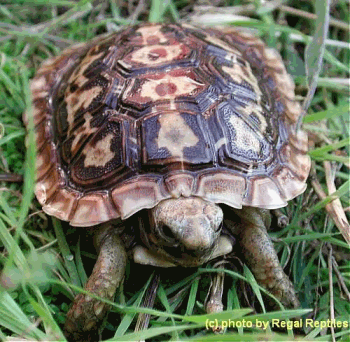
Beauty Of Animlas | Pancake Tortoise Turtle - Malacochersus Tornieri | The pancake tortoise, or Malacochersus tornieri, is a flat-shelled tortoise native to Tanzania,and Kenya. The distribution of Malacochersus tornieri has also been reported in Zambia by CHANSA and WAGNER (2006). Its name is derived from the flat shape of its shell. It is the only member of the genus Malacochersus. The species inhabits the Somalia-Masai floristic region, an arid semi-desert characterized by Acacia-Commiphora bushland and Brachystegia woodland in upland localities (WHITE 1983, BROADLEY & HOWELL 1991). It occurs in dry savannah of low altitude at small rocky hills of the crystalline basement. Unlike most tortoises, its shell is flat, flexible, and provides the tortoise less defense against predators.
The breeding seasons for this tortoise is in January and February. For protection, the Pancake Tortoise hides in small crevices, possible because of the flat shape of its shell. The carapace is brown, frequently with a variable pattern of radiating dark lines on each scute, helping to camouflage the tortoise in its natural dry habitat. The plastron is pale yellow with dark brown seams and light yellow rays, and the head, limbs and tail are yellow-brown. Its bizarre, flattened, pancake-like profile makes this tortoise a sought-after animal in zoological and private collections.
They are secretive tortoises and excellent escape artists. Their reproductive rate is low because the females only lay one egg due to their shape. They spend their days hiding in rocky areas, often stacked on top of each other. They eat leafy greens. The pancake tortoise is adapted to fitting into tight crevices. Even larger individuals are less than 2 inches high. The shell is so thin and flexible that the plastron moves in and out when the animal breathes. Since the tortoise ould easily be torn apart by predators, it relies on its speed and flexibility to escape from dangerous situations. With the reduced weight of the shell, it can move much more quickly than other species.
It was once thought that it could puff its body up with air to wedge itself in place, but this has been found not to be true. Instead, it orients its spiky legs outward so that it is almost impossible to dislodge. Also this animal can also climb vertically. Because they are so light they can turn themselves over with ease if they fall on their backs.
In the wild breeding is in January-February with nesting in July-August.They lay eggs that are about two inches long. The eggs can incubated at about 30 degrees Celsius for 140 to 190 days. Combat between males prior to breeding can lead to better reproductive success. In captivity breeding can be any time of the year. Captive animals can live 25 years and perhaps longer.
The breeding seasons for this tortoise is in January and February. For protection, the Pancake Tortoise hides in small crevices, possible because of the flat shape of its shell. The carapace is brown, frequently with a variable pattern of radiating dark lines on each scute, helping to camouflage the tortoise in its natural dry habitat. The plastron is pale yellow with dark brown seams and light yellow rays, and the head, limbs and tail are yellow-brown. Its bizarre, flattened, pancake-like profile makes this tortoise a sought-after animal in zoological and private collections.
They are secretive tortoises and excellent escape artists. Their reproductive rate is low because the females only lay one egg due to their shape. They spend their days hiding in rocky areas, often stacked on top of each other. They eat leafy greens. The pancake tortoise is adapted to fitting into tight crevices. Even larger individuals are less than 2 inches high. The shell is so thin and flexible that the plastron moves in and out when the animal breathes. Since the tortoise ould easily be torn apart by predators, it relies on its speed and flexibility to escape from dangerous situations. With the reduced weight of the shell, it can move much more quickly than other species.
It was once thought that it could puff its body up with air to wedge itself in place, but this has been found not to be true. Instead, it orients its spiky legs outward so that it is almost impossible to dislodge. Also this animal can also climb vertically. Because they are so light they can turn themselves over with ease if they fall on their backs.
In the wild breeding is in January-February with nesting in July-August.They lay eggs that are about two inches long. The eggs can incubated at about 30 degrees Celsius for 140 to 190 days. Combat between males prior to breeding can lead to better reproductive success. In captivity breeding can be any time of the year. Captive animals can live 25 years and perhaps longer.
Find Here The Kinds Of Animals and Flora and Fauna
















